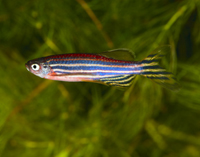Zebrafish Researcher Earns Her Stripes
|
“I believe in the power of studying animals that can naturally accomplish what we want to do therapeutically in humans.” |
|
|
The answers to degenerative diseases in human eyes could come from an unlikely source: a fish. Ann Morris, a 2011 Pew Biomedical Scholar and assistant professor at the University of Kentucky, didn't know as a child that she would study zebrafish for clues on improving human vision, but she did know that one day she'd become a scientist.
“When I was in sixth grade, my science class was assigned a report and I did mine on the structure of an atom,” Morris recalls. “I decided at that time that I just loved science and that I would become a nuclear physicist.”
But that dream changed as Morris grew up—she majored in French as an undergraduate at Florida State University and worked at a newspaper in Tallahassee. A few years into her professional life, Morris' scientific ambitions came back into focus. She left the paper to pursue an undergraduate degree in biochemistry, again at Florida State.
“I fell in love with the idea of trying to figure out how genes are turned on and off and how gene expression is regulated,” she says. She wanted a closer look at how creatures as complex as humans start as a single cell.
While at Emory, Morris marveled at the discovery that the gene PAX6 initiates a huge cascade of molecular events resulting in embryos' successful eye development. Although initial PAX6 studies were done in fruit flies, Morris knew the work could matter to people. In humans, she notes, “the same sort of on-and-off switch is at work.”
As one of 22 early-career researchers selected as Pew Biomedical Scholars in 2011, Morris opted to watch eye development—and its potential mishaps—in action within zebrafish. Their embryos are transparent, allowing scientists to observe development unfolding. And unlike humans, adult zebrafish can regenerate damaged tissues and organs, including eyes.
Morris then earned her doctorate at Emory University in genetics and molecular biology. Along the way, one of biology's most fundamental questions came to her attention.
“I believe in the power of studying animals that can naturally accomplish what we want to do therapeutically in humans,” Morris says. She envisions her work leading to ways to reverse vision-wrecking cell damage wrought by disorders such as retinitis pigmentosa, macular degeneration and retinal detachment.
Morris and her team are researching the genes governing how rod and cone precursor cells differentiate into the structures necessary for vision. They also examine transcription factors, powerful molecules in cells that can switch specific genes on or off.
Morris hopes her work will eventually allow clinicians to seed damaged human eye tissues with cells that would develop into new rods and cones and wire up with the surrounding cells in the retina. If she can pull that off, a therapeutic strategy for millions of people with lost or damaged vision could be in reach.
But much work on countless fish stands between Morris and those vision-restoring treatments. “This research requires innovative, risk-taking projects that are hard to get funding for, but which Pew is looking to support,” she offers. The Biomedical scholars program award will help her see it through.
See more profiles here.
Photo of Ann Morris by Mark Cornelison/University of Kentucky.
Since 1985, Pew's biomedical programs have been supporting promising beginning researchers in the health sciences—particularly young investigators with innovative approaches and ideas. This article is the second in a "Biomedical Researcher of the Month" series highlighting Pew's biomedical programs.













